Hungarian vs Tongan Community Comparison
COMPARE
Hungarian
Tongan
Social Comparison
Social Comparison
Hungarians
Tongans
6,572
SOCIAL INDEX
63.2/ 100
SOCIAL RATING
149th/ 347
SOCIAL RANK
7,132
SOCIAL INDEX
68.8/ 100
SOCIAL RATING
130th/ 347
SOCIAL RANK
Tongan Integration in Hungarian Communities
The statistical analysis conducted on geographies consisting of 99,163,940 people shows a mild positive correlation between the proportion of Tongans within Hungarian communities in the United States with a correlation coefficient (R) of 0.311. On average, for every 1% (one percent) increase in Hungarians within a typical geography, there is an increase of 0.070% in Tongans. To illustrate, in a geography comprising of 100,000 individuals, a rise of 1,000 Hungarians corresponds to an increase of 69.5 Tongans.
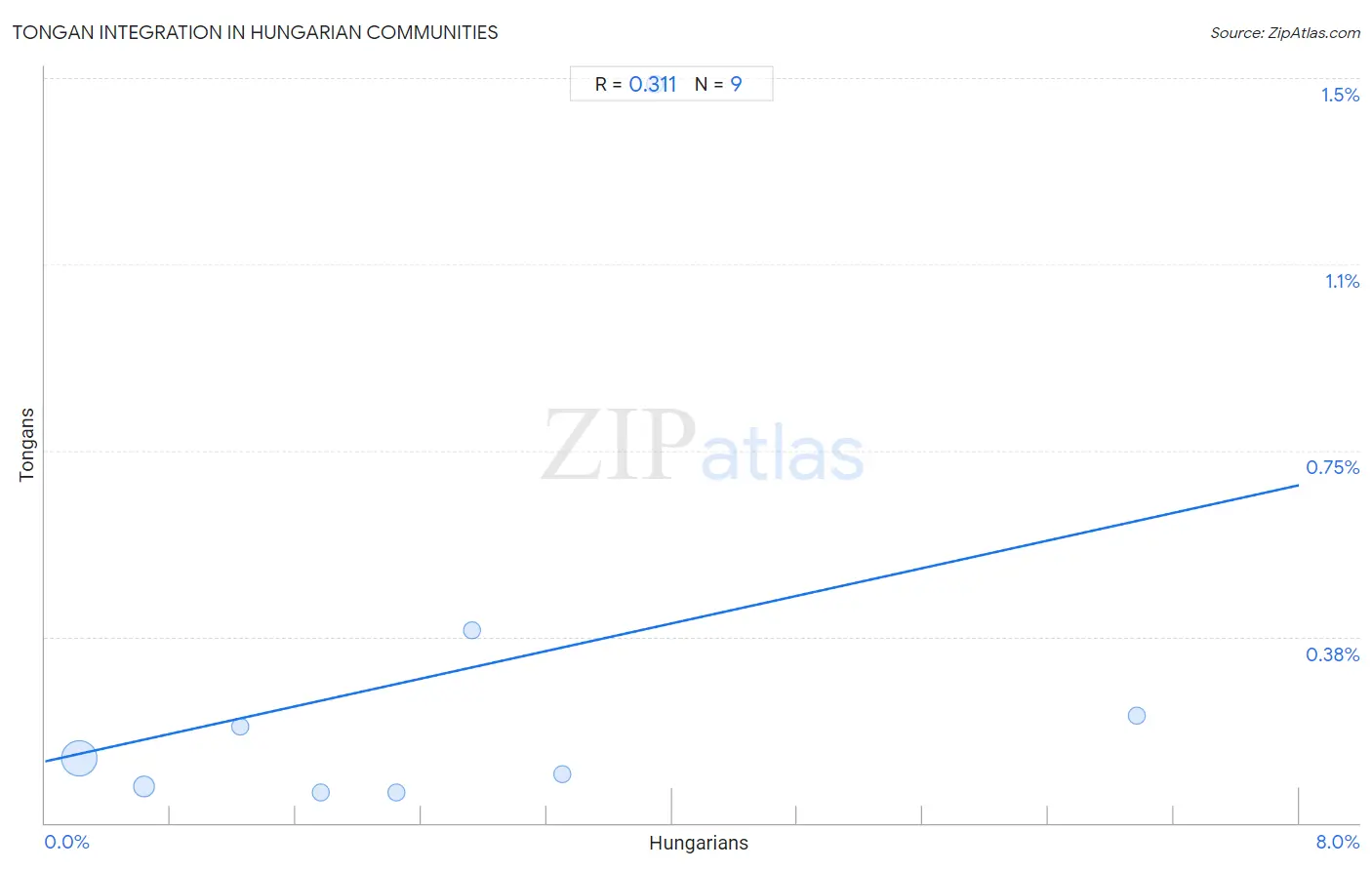
Hungarian vs Tongan Income
When considering income, the most significant differences between Hungarian and Tongan communities in the United States are seen in householder income under 25 years ($50,247 compared to $56,972, a difference of 13.4%), householder income over 65 years ($61,673 compared to $68,235, a difference of 10.6%), and per capita income ($45,426 compared to $41,693, a difference of 9.0%). Conversely, both communities are more comparable in terms of median family income ($105,609 compared to $105,967, a difference of 0.34%), householder income ages 25 - 44 years ($97,544 compared to $99,604, a difference of 2.1%), and median female earnings ($39,510 compared to $38,288, a difference of 3.2%).

| Income Metric | Hungarian | Tongan |
| Per Capita Income | Excellent $45,426 | Tragic $41,693 |
| Median Family Income | Excellent $105,609 | Excellent $105,967 |
| Median Household Income | Good $86,920 | Exceptional $93,076 |
| Median Earnings | Excellent $47,795 | Fair $45,665 |
| Median Male Earnings | Exceptional $57,309 | Fair $53,218 |
| Median Female Earnings | Average $39,510 | Tragic $38,288 |
| Householder Age | Under 25 years | Tragic $50,247 | Exceptional $56,972 |
| Householder Age | 25 - 44 years | Excellent $97,544 | Exceptional $99,604 |
| Householder Age | 45 - 64 years | Excellent $103,913 | Exceptional $108,643 |
| Householder Age | Over 65 years | Good $61,673 | Exceptional $68,235 |
| Wage/Income Gap | Tragic 29.0% | Tragic 27.5% |
Hungarian vs Tongan Poverty
When considering poverty, the most significant differences between Hungarian and Tongan communities in the United States are seen in single father poverty (18.5% compared to 12.2%, a difference of 51.1%), single male poverty (13.8% compared to 10.5%, a difference of 31.9%), and child poverty under the age of 5 (17.9% compared to 14.2%, a difference of 26.4%). Conversely, both communities are more comparable in terms of seniors poverty over the age of 65 (9.7% compared to 9.3%, a difference of 4.1%), seniors poverty over the age of 75 (11.2% compared to 10.5%, a difference of 6.9%), and female poverty (13.2% compared to 11.9%, a difference of 10.8%).
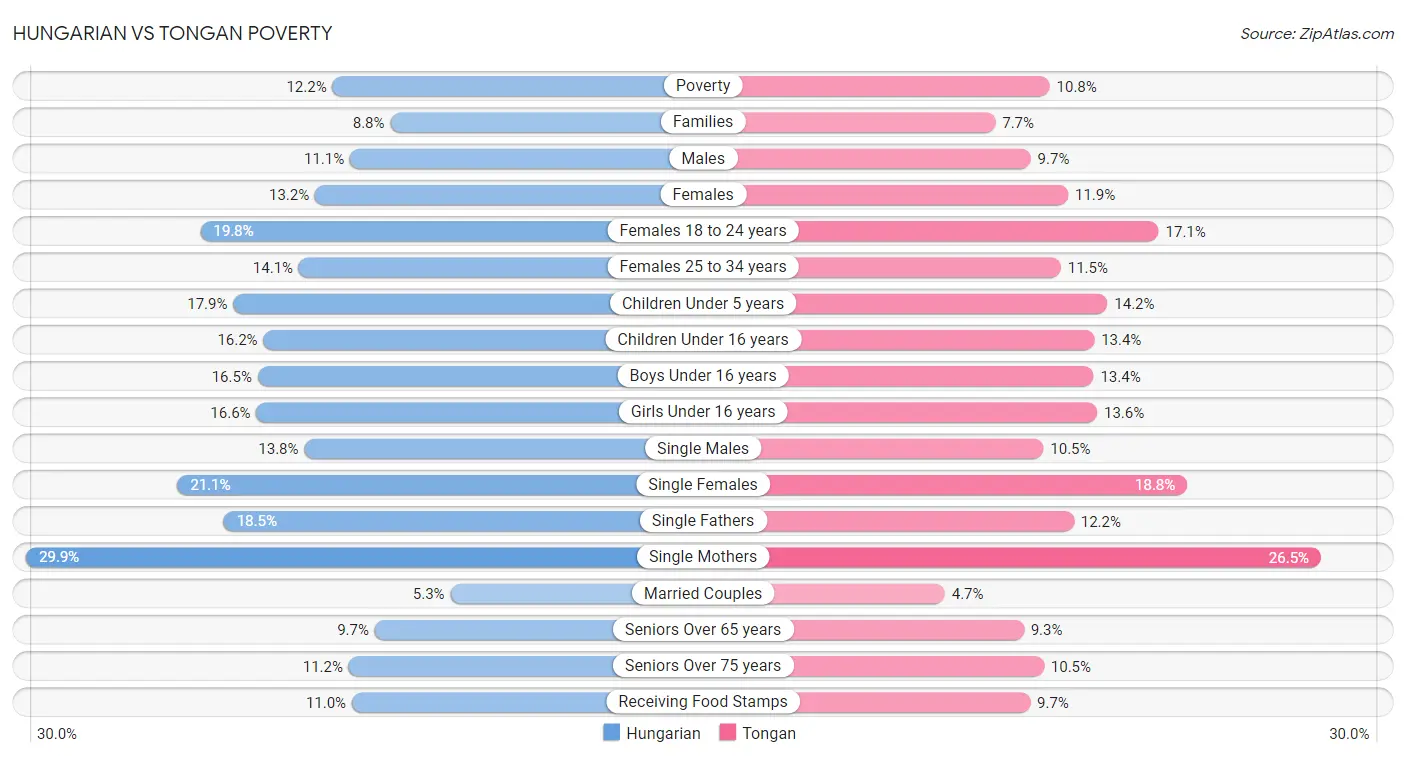
| Poverty Metric | Hungarian | Tongan |
| Poverty | Good 12.2% | Exceptional 10.8% |
| Families | Good 8.8% | Exceptional 7.7% |
| Males | Average 11.1% | Exceptional 9.7% |
| Females | Good 13.2% | Exceptional 11.9% |
| Females 18 to 24 years | Good 19.8% | Exceptional 17.1% |
| Females 25 to 34 years | Poor 14.1% | Exceptional 11.5% |
| Children Under 5 years | Poor 17.9% | Exceptional 14.2% |
| Children Under 16 years | Average 16.2% | Exceptional 13.4% |
| Boys Under 16 years | Average 16.5% | Exceptional 13.4% |
| Girls Under 16 years | Average 16.6% | Exceptional 13.6% |
| Single Males | Tragic 13.8% | Exceptional 10.5% |
| Single Females | Fair 21.1% | Exceptional 18.8% |
| Single Fathers | Tragic 18.5% | Exceptional 12.2% |
| Single Mothers | Poor 29.9% | Exceptional 26.5% |
| Married Couples | Fair 5.3% | Exceptional 4.7% |
| Seniors Over 65 years | Exceptional 9.7% | Exceptional 9.3% |
| Seniors Over 75 years | Exceptional 11.2% | Exceptional 10.5% |
| Receiving Food Stamps | Excellent 11.0% | Exceptional 9.7% |
Hungarian vs Tongan Unemployment
When considering unemployment, the most significant differences between Hungarian and Tongan communities in the United States are seen in unemployment among women with children ages 6 to 17 years (9.3% compared to 6.7%, a difference of 38.9%), unemployment among ages 25 to 29 years (6.8% compared to 5.5%, a difference of 22.4%), and unemployment among ages 65 to 74 years (5.5% compared to 4.7%, a difference of 16.0%). Conversely, both communities are more comparable in terms of female unemployment (4.9% compared to 4.8%, a difference of 2.1%), unemployment among seniors over 75 years (10.1% compared to 10.4%, a difference of 2.9%), and unemployment among youth under 25 years (11.4% compared to 10.9%, a difference of 4.1%).
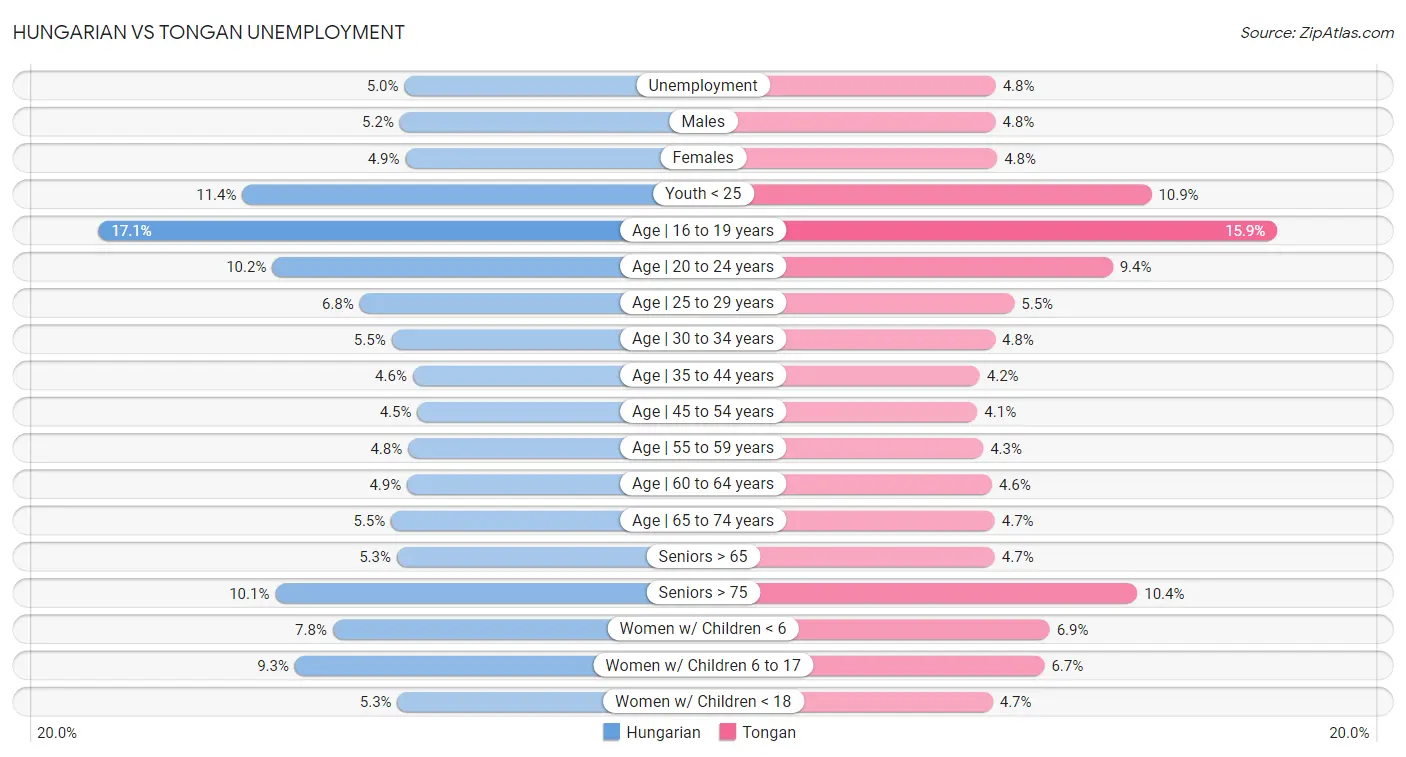
| Unemployment Metric | Hungarian | Tongan |
| Unemployment | Exceptional 5.0% | Exceptional 4.8% |
| Males | Excellent 5.2% | Exceptional 4.8% |
| Females | Exceptional 4.9% | Exceptional 4.8% |
| Youth < 25 | Excellent 11.4% | Exceptional 10.9% |
| Age | 16 to 19 years | Exceptional 17.1% | Exceptional 15.9% |
| Age | 20 to 24 years | Good 10.2% | Exceptional 9.4% |
| Age | 25 to 29 years | Fair 6.8% | Exceptional 5.5% |
| Age | 30 to 34 years | Average 5.5% | Exceptional 4.8% |
| Age | 35 to 44 years | Good 4.6% | Exceptional 4.2% |
| Age | 45 to 54 years | Good 4.5% | Exceptional 4.1% |
| Age | 55 to 59 years | Average 4.8% | Exceptional 4.3% |
| Age | 60 to 64 years | Average 4.9% | Exceptional 4.6% |
| Age | 65 to 74 years | Tragic 5.5% | Exceptional 4.7% |
| Seniors > 65 | Tragic 5.3% | Exceptional 4.7% |
| Seniors > 75 | Tragic 10.1% | Tragic 10.4% |
| Women w/ Children < 6 | Fair 7.8% | Exceptional 6.9% |
| Women w/ Children 6 to 17 | Tragic 9.3% | Exceptional 6.7% |
| Women w/ Children < 18 | Excellent 5.3% | Exceptional 4.7% |
Hungarian vs Tongan Labor Participation
When considering labor participation, the most significant differences between Hungarian and Tongan communities in the United States are seen in in labor force | age > 16 (63.8% compared to 67.5%, a difference of 5.8%), in labor force | age 16-19 (39.8% compared to 41.2%, a difference of 3.4%), and in labor force | age 20-24 (76.3% compared to 77.9%, a difference of 2.1%). Conversely, both communities are more comparable in terms of in labor force | age 25-29 (84.6% compared to 84.7%, a difference of 0.030%), in labor force | age 45-54 (82.7% compared to 83.1%, a difference of 0.55%), and in labor force | age 35-44 (84.2% compared to 83.6%, a difference of 0.73%).

| Labor Participation Metric | Hungarian | Tongan |
| In Labor Force | Age > 16 | Tragic 63.8% | Exceptional 67.5% |
| In Labor Force | Age 20-64 | Tragic 79.2% | Exceptional 80.3% |
| In Labor Force | Age 16-19 | Exceptional 39.8% | Exceptional 41.2% |
| In Labor Force | Age 20-24 | Exceptional 76.3% | Exceptional 77.9% |
| In Labor Force | Age 25-29 | Average 84.6% | Average 84.7% |
| In Labor Force | Age 30-34 | Fair 84.5% | Tragic 83.5% |
| In Labor Force | Age 35-44 | Fair 84.2% | Tragic 83.6% |
| In Labor Force | Age 45-54 | Fair 82.7% | Excellent 83.1% |
Hungarian vs Tongan Family Structure
When considering family structure, the most significant differences between Hungarian and Tongan communities in the United States are seen in single father households (2.2% compared to 2.5%, a difference of 16.0%), family households with children (27.6% compared to 31.2%, a difference of 13.1%), and births to unmarried women (31.2% compared to 28.4%, a difference of 10.1%). Conversely, both communities are more comparable in terms of currently married (48.8% compared to 48.3%, a difference of 1.0%), single mother households (5.7% compared to 5.8%, a difference of 3.0%), and married-couple households (49.1% compared to 51.6%, a difference of 5.1%).

| Family Structure Metric | Hungarian | Tongan |
| Family Households | Exceptional 64.9% | Exceptional 69.6% |
| Family Households with Children | Good 27.6% | Exceptional 31.2% |
| Married-couple Households | Exceptional 49.1% | Exceptional 51.6% |
| Average Family Size | Tragic 3.18 | Exceptional 3.49 |
| Single Father Households | Exceptional 2.2% | Tragic 2.5% |
| Single Mother Households | Exceptional 5.7% | Exceptional 5.8% |
| Currently Married | Exceptional 48.8% | Exceptional 48.3% |
| Divorced or Separated | Good 12.0% | Exceptional 11.1% |
| Births to Unmarried Women | Good 31.2% | Exceptional 28.4% |
Hungarian vs Tongan Vehicle Availability
When considering vehicle availability, the most significant differences between Hungarian and Tongan communities in the United States are seen in 4 or more vehicles in household (6.4% compared to 10.0%, a difference of 56.9%), no vehicles in household (9.9% compared to 7.2%, a difference of 38.3%), and 3 or more vehicles in household (19.8% compared to 26.5%, a difference of 33.9%). Conversely, both communities are more comparable in terms of 1 or more vehicles in household (90.3% compared to 92.9%, a difference of 2.8%), 2 or more vehicles in household (56.5% compared to 63.5%, a difference of 12.4%), and 3 or more vehicles in household (19.8% compared to 26.5%, a difference of 33.9%).

| Vehicle Availability Metric | Hungarian | Tongan |
| No Vehicles Available | Excellent 9.9% | Exceptional 7.2% |
| 1+ Vehicles Available | Excellent 90.3% | Exceptional 92.9% |
| 2+ Vehicles Available | Excellent 56.5% | Exceptional 63.5% |
| 3+ Vehicles Available | Good 19.8% | Exceptional 26.5% |
| 4+ Vehicles Available | Good 6.4% | Exceptional 10.0% |
Hungarian vs Tongan Education Level
When considering education level, the most significant differences between Hungarian and Tongan communities in the United States are seen in no schooling completed (1.6% compared to 2.3%, a difference of 42.9%), professional degree (4.6% compared to 3.7%, a difference of 24.8%), and master's degree (15.6% compared to 12.5%, a difference of 24.6%). Conversely, both communities are more comparable in terms of nursery school (98.5% compared to 97.8%, a difference of 0.74%), kindergarten (98.5% compared to 97.7%, a difference of 0.74%), and 1st grade (98.4% compared to 97.7%, a difference of 0.76%).
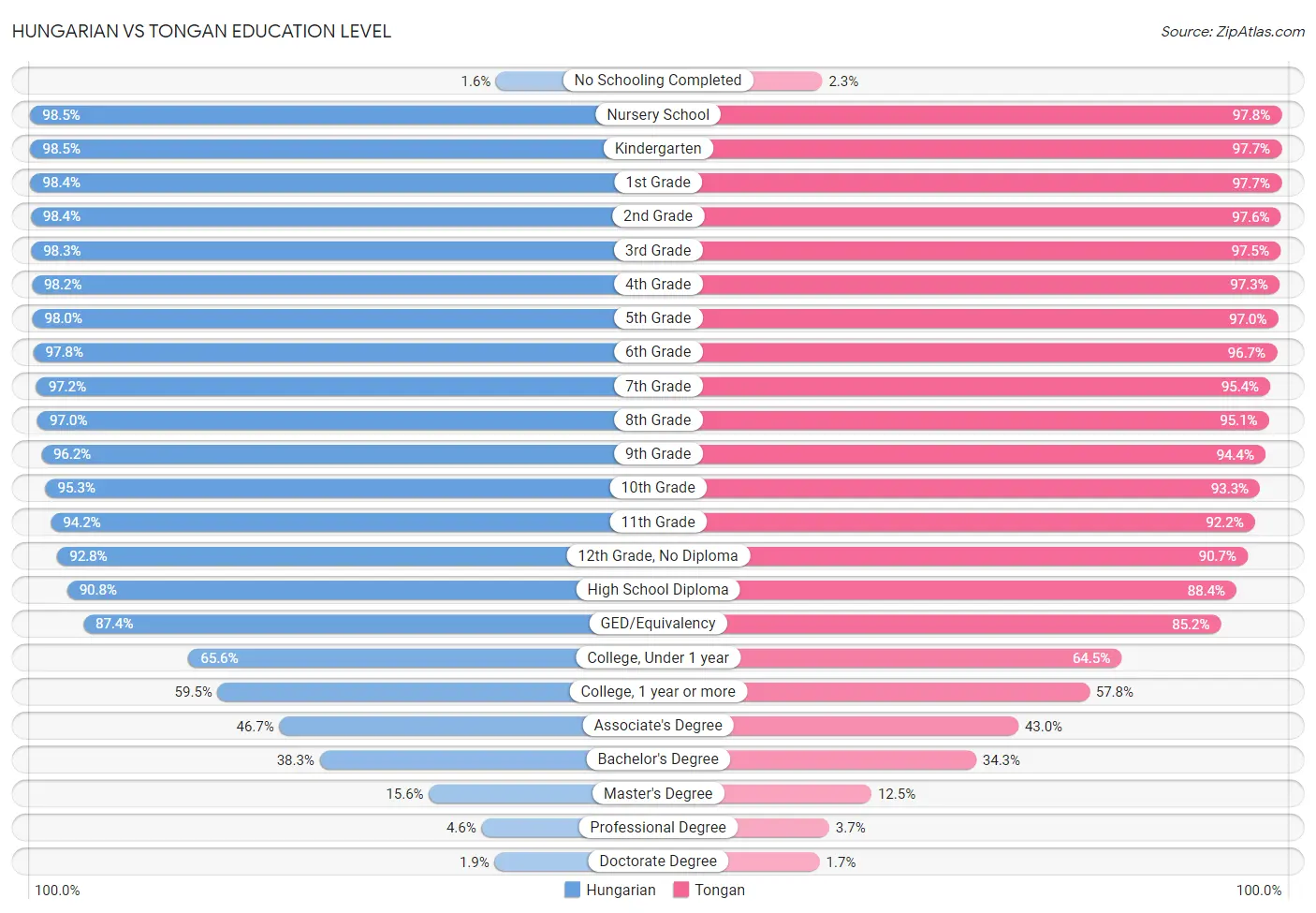
| Education Level Metric | Hungarian | Tongan |
| No Schooling Completed | Exceptional 1.6% | Tragic 2.3% |
| Nursery School | Exceptional 98.5% | Tragic 97.8% |
| Kindergarten | Exceptional 98.5% | Tragic 97.7% |
| 1st Grade | Exceptional 98.4% | Tragic 97.7% |
| 2nd Grade | Exceptional 98.4% | Tragic 97.6% |
| 3rd Grade | Exceptional 98.3% | Tragic 97.5% |
| 4th Grade | Exceptional 98.2% | Tragic 97.3% |
| 5th Grade | Exceptional 98.0% | Tragic 97.0% |
| 6th Grade | Exceptional 97.8% | Tragic 96.7% |
| 7th Grade | Exceptional 97.2% | Tragic 95.4% |
| 8th Grade | Exceptional 97.0% | Tragic 95.1% |
| 9th Grade | Exceptional 96.2% | Tragic 94.4% |
| 10th Grade | Exceptional 95.3% | Tragic 93.3% |
| 11th Grade | Exceptional 94.2% | Poor 92.2% |
| 12th Grade, No Diploma | Exceptional 92.8% | Poor 90.7% |
| High School Diploma | Exceptional 90.8% | Tragic 88.4% |
| GED/Equivalency | Exceptional 87.4% | Fair 85.2% |
| College, Under 1 year | Average 65.6% | Fair 64.5% |
| College, 1 year or more | Average 59.5% | Poor 57.8% |
| Associate's Degree | Average 46.7% | Tragic 43.0% |
| Bachelor's Degree | Good 38.3% | Tragic 34.3% |
| Master's Degree | Good 15.6% | Tragic 12.5% |
| Professional Degree | Excellent 4.6% | Tragic 3.7% |
| Doctorate Degree | Good 1.9% | Poor 1.7% |
Hungarian vs Tongan Disability
When considering disability, the most significant differences between Hungarian and Tongan communities in the United States are seen in ambulatory disability (6.3% compared to 5.4%, a difference of 17.0%), disability age under 5 (1.5% compared to 1.3%, a difference of 16.6%), and hearing disability (3.4% compared to 2.9%, a difference of 16.6%). Conversely, both communities are more comparable in terms of disability age over 75 (46.5% compared to 48.3%, a difference of 3.9%), disability age 65 to 74 (22.4% compared to 23.8%, a difference of 6.0%), and cognitive disability (16.5% compared to 17.8%, a difference of 7.8%).
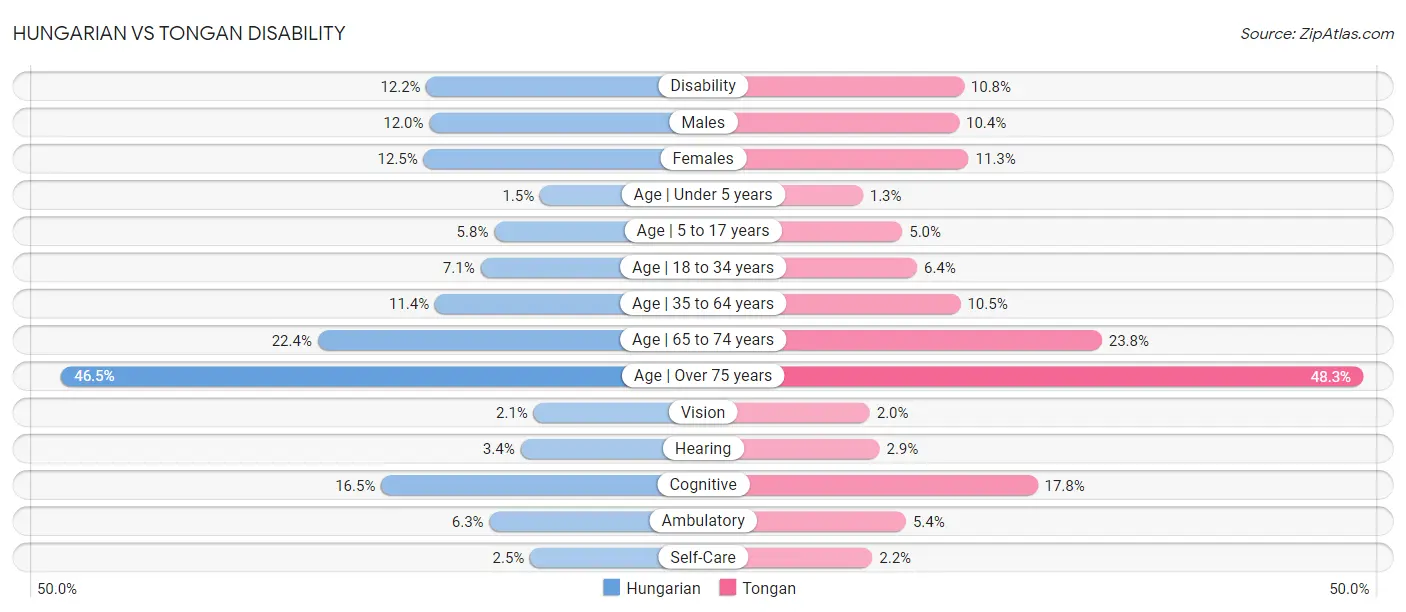
| Disability Metric | Hungarian | Tongan |
| Disability | Tragic 12.2% | Exceptional 10.8% |
| Males | Tragic 12.0% | Exceptional 10.4% |
| Females | Tragic 12.5% | Exceptional 11.3% |
| Age | Under 5 years | Tragic 1.5% | Tragic 1.3% |
| Age | 5 to 17 years | Tragic 5.8% | Exceptional 5.0% |
| Age | 18 to 34 years | Tragic 7.1% | Excellent 6.4% |
| Age | 35 to 64 years | Fair 11.4% | Exceptional 10.5% |
| Age | 65 to 74 years | Exceptional 22.4% | Fair 23.8% |
| Age | Over 75 years | Exceptional 46.5% | Tragic 48.3% |
| Vision | Good 2.1% | Exceptional 2.0% |
| Hearing | Tragic 3.4% | Good 2.9% |
| Cognitive | Exceptional 16.5% | Tragic 17.8% |
| Ambulatory | Tragic 6.3% | Exceptional 5.4% |
| Self-Care | Average 2.5% | Exceptional 2.2% |